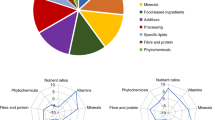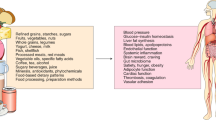Abstract
Food quality has increasingly become one of the main drivers of food choice, and attributes such as food composition are gaining importance in product quality considerations. This paper describes food quality trends observed in the international context and the manifestation of these trends within the food industry. From a consumer's perspective, improved knowledge of the composition and function of foods has contributed to many of these food trends. Science-driven health education could continue these positive changes in nutritional behaviour. Consumer health education projects, often called social marketing campaigns, aim to promote awareness of the health and nutritional advantages of foods, on the basis of composition data, in an effort to change behaviour. Agents of change in this process must be believable and trustworthy. To effectively promote healthy lifestyles to reduce the global burden of malnutrition and non-communicable diseases, consumer education requires a wide multisectoral approach. This approach needs to involve various sectors, including government, health professionals, the science fraternity and the private sector.
This is a preview of subscription content, access via your institution
Access options
Subscribe to this journal
Receive 12 print issues and online access
$259.00 per year
only $21.58 per issue
Buy this article
- Purchase on Springer Link
- Instant access to full article PDF
Prices may be subject to local taxes which are calculated during checkout

Similar content being viewed by others
References
Bruce A (2000). Strategies to prevent the metabolic syndrome at the population level: role of authorities and non-government bodies. Br J Nutr 83 (Suppl 1), S181–S186.
Cancer Society of New Zealand (2008). Function Catering Guidelines. Canterbury West Coast Division Heart Foundation of New Zealand: Christchurch, New Zealand. Available online at: http://www.cancernz.org.nz/assets/files/Catering%20guidelines.pdf (accessed on December 2009).
Casey NH, Webb EC (1995). Influence of dietary energy levels and form of diet on composition of fatty acids in subcutaneous adipose tissue of wethers. Small Ruminant Research 18 (Suppl 2), 125–132.
CDC (Centre for Disease Control Prevention) (2006). State specific prevalence of obesity among adults—United States 2006. MMWR Wkly 55, 985–988. (Available online at: http://www.cdc.gov).
Chan W, Brown J, Lee SM, Buss DH (1995). Meat, poultry and game. Supplement to McCance and Widdowson's: The Composition of Food. The Royal Society of Chemistry, Ministry of Agriculture, Fisheries and Food: London.
Clay WD (1997). Preparation and use of food-based dietary guidelines. FNA/ANA 19, 42–47.
Demographic and Health Survey (2003). South African Department of Health. Available online at: http://www.doh.gov.za/facts/index.html (accessed on December 2009).
Duvenhage SS, Schonfeldt HC, Kruger R (2010). Food product attributes guiding purchasing choice of maize meal by low-income South African consumers. Dev South Afr 27, accepted for print. No. CDSA498940.
FAO/WHO (Food and Agriculture Organization/World Health Organization) (1992). In: International Conference on Nutrition. Food Nutrition and Agriculture, 5/6, Rome.
Gibney MJ, Wolmerans P (2004). Dietary Guidelines. In: Gibney MJ, Margetts BM, Kearney JM, Arab L (eds). Public Health Nutrition The nutrition society textbook series, Dietary Guidelines, Blackwell Science: Oxford, 133–143.
Greenfield H, Southgate DAT (2003). Food Composition Data: Production, Management and Use, 2nd edn. Food and Agriculture Organization of the United Nations: Rome.
Higgs JD (2000). The changing nature of red meat: 20 years of improving nutritional quality. Trends Food Sci and Tech 11, 85–95.
Househam KC (2010). Africa's burden of diseases: the University of Cape Town Sub-Saharan Africa Centre for Chronic Disease. Editorial. SAMJ 100, 95.
IFIC (International Food Information Council) Foundation (2006). Food and Health Survey: Consumer Attitude Towards Food, Nutrition and Health. (Available online at: http://ific.org).
Johnson RK, Kennedy E (2000). The 2000 dietary guidelines for Americans: what era the changes and why were they made? J Am Diet Assoc 100, 769–774.
Laugesen M (2005). Decreased red meat fat consumption in New Zealand: 1995-2002. N Z Med J 118, U1751.
Labadarios D (ed) (1999). National Food Consumption Survey (NFCS): Children aged 1—years in South Africa, 1999: Available online: http://www.sahealthinfo.org/nutrition/foodconsumption.htm.
Musgrave C (2007). Childhood obesity: the problem? The solution? Nutr Bull 32, 406–411.
Naudé RT (1994). Nutritional composition: introduction. In Proc meat as food workshop. Meat Industry Centre, Irene Animal Production Institute: Irene, 68–74.
Norman R, Bradshaw D, Schneider M, Joubert J, Groenewald P, Lewin S et al. and the South African Risk Assesment Collaborating Group (2007). A comparative risk assessment for South Africa in 2000: towards promoting health and preventing disease. SAMJ 97, 637–641.
Peng Y (2004). Canadian consumer trends in obesity and food consumption. Consumer Food Trends Alberta Agriculture, Food and Rural Development.
Pollard J, Kirk SFL, Cade JE (2002). Factors affecting food choice in relation to fruit and vegetable intake: a review. Nutr Res Rev 15, 373–387.
Radder L, Le Roux R (2005). Factors affecting food choice in relation to venison: a South African example. Meat Sci 71, 583–589.
Sayed N, Frans Y, Schönfeldt HC (1999). Composition of South African Foods: Milk and Milk products; Eggs, Meat and Meat Products. Medical Research Council: Tygerberg, South Africa, ISBN 1-919809-07-4.
Schönfeldt HC, Gibson N (2008). Changes in the nutrient content of meat in an obesity of context. Meat Sci 80, 20–27.
Schönfeldt HC, Holden J (2009). Food Composition data in nutrition. In: Gibney MJ, Vorster HH, Kok FJ (eds). Introduction to Human Nutrition. The Nutrition Society Textbook Series. Blackwell Science Ltd.: Oxford.
Steyn NP, Bradshaw D, Norman R, Joubert J, Schneider M, Steyn K (2006). Dietary changes and the health transition in South Africa: implication for health policy. Executive Summary. Chronic disease of lifestyle Unit and Burden of Disease Research Unit of the South African Medical Research Council: Cape Town, South Africa.
Van Heerden SM, Schönfeldt HC, Kruger R, Smith MF (2007). The nutrient composition of South African lamb (A2 grade). JFCA 20, 671–680.
WHO (World Health Organization) (2004). Global Strategy on Diet, Physical Activity and Health: 2004. ISBN: 92 4 159222 2.
WHO (World Health Organization) (2008). The Global Burden of Disease: 2004 Update. WHO: Geneva.
WHO (World Health Organization) (2010). World Health Statistics. World Health Organization: Geneva.
Author information
Authors and Affiliations
Corresponding author
Ethics declarations
Competing interests
The authors declare no conflict of interest.
Rights and permissions
About this article
Cite this article
Schönfeldt, H., Gibson, N. Food composition data in health communication. Eur J Clin Nutr 64 (Suppl 3), S128–S133 (2010). https://doi.org/10.1038/ejcn.2010.223
Published:
Issue Date:
DOI: https://doi.org/10.1038/ejcn.2010.223



